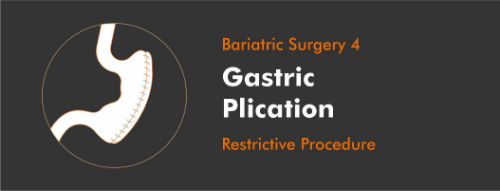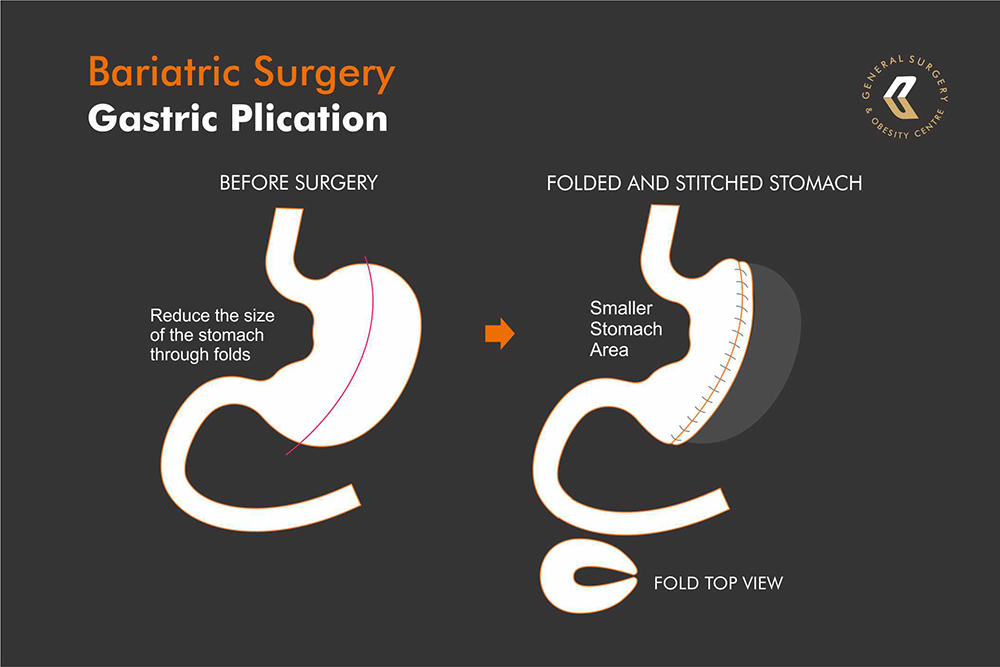
What is Gastric Plication?
Also know as
Background of Gastric Plication
Who is a suitable candidate for Gastric Plication?
When your BMI is over 30 and you suffer from obesity related conditions such as
- Sleep Apnea
- Fatty liver disease
- Type 2 diabetes
- Hypertension
Gastric Plication has also been a preffered choice by younger patients whoo suffer from obesity.

How is the Gastric Plication Performed?
Under general anesthesia. A laparoscopic telescope with a camera and instruments are used to perform the procedure. This enables the doctor to access the stomach area.
The surgeon makes a fold within the patient’s stomach and sutures the ends together. Another fold is formed and sutured. This reduces the stomach capacity, as a result the patient feels fuller faster They cannot eat as much as they used to, which leads to rapid weight loss.
What are the benefits of Gastric Plication?
- Shorter prodecure and recovery time.
- Less invasive than other surgical procedures as it does not involve any cutting or stapling.
- Gastric Plication does not require rerouting of intestines as with gastric bypass.
- Reduction of conditions associated with obesity such as,
- Type 2 diabetes, fatty liver disease, sleep apnea and other morbid conditions are greatly reduced.
- Cancer including breast, colon, kidney, liver, ovarian, pancreatic and thyroid cancers.
- Essential hypertension is relieved in over 70% of patients.
- Lower-back pain and joint pain are typically relieved or improved in nearly all patients.
- Leg swelling are typically alleviated.
How much weight can I lose with Gastric Plication?
Studies show that patients lose approximately short-term percentage of excess weight lost ranges from 30 to 55% within 2 years.
What to expect after Sleeve Gastric Plication?
This is usually individualized based on the surgery and the patient.
- Most patients require pain medication for one week following surgery.
- It may be advised to avoid intercourse, baths, douching, strenuous exercise or heavy lifting for 4-6 weeks after the operation.
Gastric Plication normal recovery times
- Most people stay in the hospital for 2 to 3 days.
- Patients can return to work within 5 to 7 days.
- Get back to normal activities in 3 to 5 weeks.
Walking exercises and raising the legs when seated are important. These light activities will reduce the chance of blood clots.
Gastric Plication Nutrition
- Dietary requirements for the first few days after the operation will include fluids such as small sips of water, low-calorie drinks and sugar-free juices.
- Patients must avoid malnutrition after a by eating sufficient protein every day.
- Patients should take supplements, vitamins and minerals to avoid deficiencies. (Vitamin D, Calcium, Iron and Vitamin B12)
Gastric Plication lifestyle changes
Bariatric surgery improves your quality of life as you progress you will:
- Improve confidence
- Improve breathing
- Increase energy and stamina
- Relieve joint pain caused by obesity
As the excess weight is lost, exercise will become easier and more enjoyable, you will build stamina and improve cardiovascular fitness.
Risk factors for Gastric Plication
These may include
- heavy bleeding
- infection
- blood clots formed in the legs
- side effects of anesthesia
- Lung or breathing problems.
Gastric Plication is relatively a low risk with limited complications associated with the procedure
Risks related to Gastric Plication procedure might be
- Opening of the stomach fold this will require additional surgery to correct
- Leakage of gastric juice
- Narrowing of the inner diameter of the nasogastric infection and
- Nutrient malabsorption where the stomach does not absorb enough nutrients
- Nausea and vomiting but should last about a week
